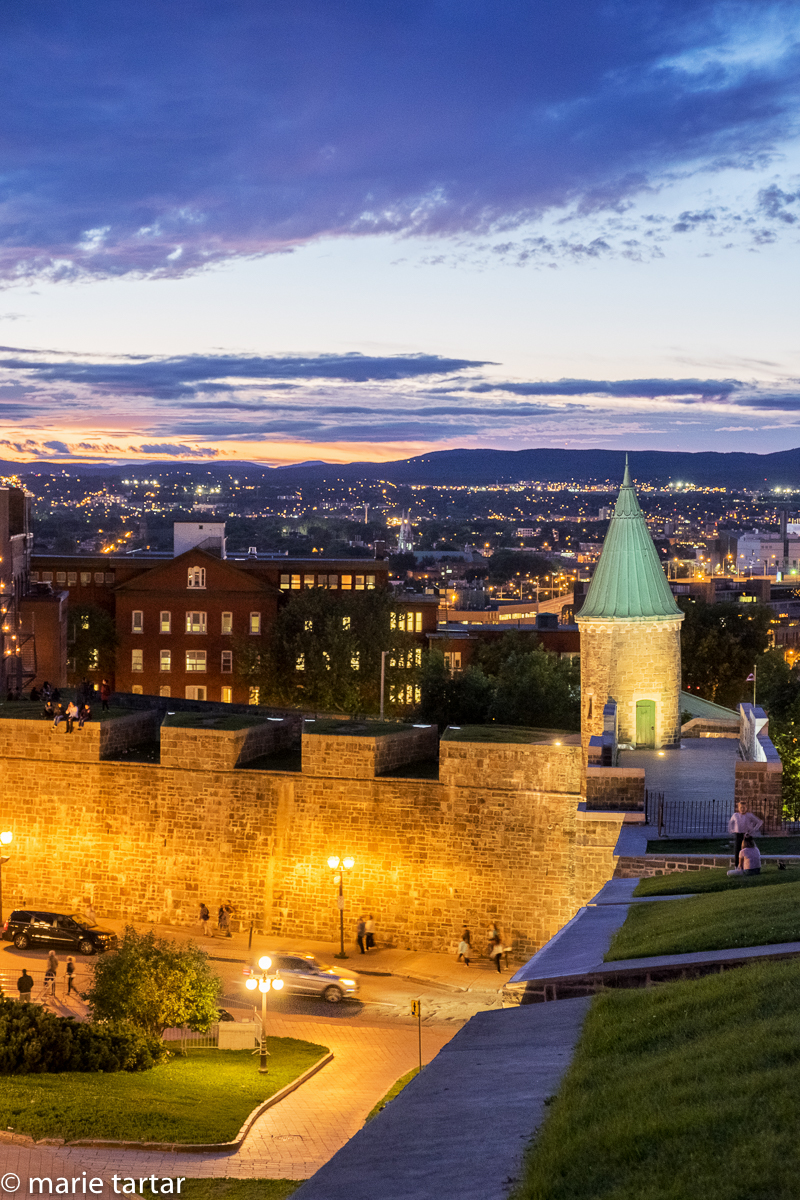
Saturday, July 16, 2016
I think I have known for most of my adult life that I would like Québec City. What’s not to like? A European-feeling city, an enclave of French culture in North America. It sounded appealing well before I spoke a word of French. It only took me 30 years to get there.

Speaking French is not essential to enjoying Québec City or Montréal…but it does add to the enjoyment derived from understanding word play on signs. This chain of convenience stores, for example. One can guess the meaning with the owl logo, but knowing coucher (verb, to sleep or lie) and tard (late, like tardy in English) suggests the meaning: Night Owl
A request for a home exchange finally pushed Québec City up the mental list. In the summer of 2015, an inquiry came, with an offer to exchange for an attractive apartment in Québec. The “best location in town” billing was compelling, in the lovely neighborhood of Montcalm, situated across the street from the Plains of Abraham, the Central Park of Québec. We had never been to Montréal either, another city for which we had heard only glowing reports.
We decided two weeks would be an adequate introduction. I decided to fly into Québec City (hereafter referred to as QC, to distinguish it from Québec, the province) and fly out of Montréal. How we would get from one to the other was decided only a few weeks before. We elected to rent a car for a week in the middle of the 2 weeks, ending up by dropping the car in Montréal and managing without one there.
Getting there was painless, just a loooong travel day-no surprise, it takes all day to traverse North America! Downloading the Air Canada Rouge phone app enabled me to watch a wonderful film, “Our Little Sister”, by the great Japanese director, Kore-Eda.
Sunday, July 17, 2016
At mid-day, my sister Clarissa joined us from New York for the week. By this time, we were comfortably situated in the lovely 3 bedroom, 2 bath apartment, in a tree-shaded neighborhood of small brick apartment buildings which reminded me strongly of St- Louis. We became acquainted with lively avenue Cartier, just 3 blocks away, a street lined with markets, restaurants, and bars, including multiple purveyors under the roof of a converted garage, Les Halles Cartier. Waklking along Grand Allée Est toward Vieux-Québec landed us in Place d’Armes in the old city, once a military training ground.
On a tree-shaded bench in Place d’Armes, we made the acquaintance of a white-haired man who fondly stroked his snow-white pet rabbit, Sparky.
Inside Quebec city’s most famous landmark, the Château Frontenac, we found souvenirs at the Fairmont store, in the form of a red and black cashmere poncho for me and a fabric bag for Clarissa.

Québec City is a walled former fortress, crowned by its most distinctive landmark, the Chateau Frontenac (this view is from La Citadelle)
The late afternoon sun produced great shadows along Terrasse Dufferin, a wide promenade extending from Chateau Frontenac, with views across the St. Lawrence River below.
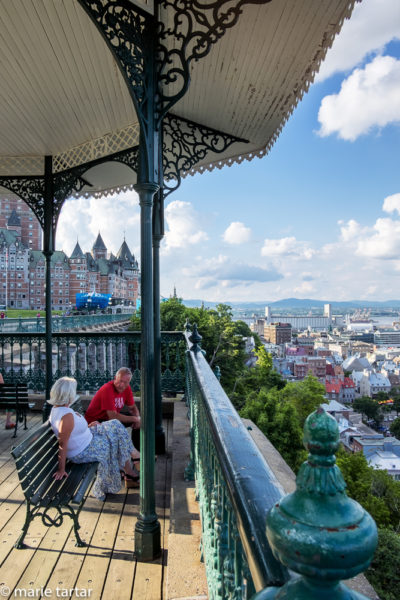
Taking in the view across the St. Lawrence River on Terrace Dufferin, Québec City; Chateau Frontenac is in the background
After successfully descending without breaking our necks the well named Casse-Cou Escalier to Petit Champlain in the Lower Town, Steve bought yet another beret to add to his growing collection of barely worn headgear in our closet. It was the final day of the annual summer Festival d’Été, limiting our access to Promenade des Gouverneurs, as I was to belatedly discover a few days later. We climbed, panting and sweating, up the Escalier du Cap-Blanc. We estimated there were more than 500 steps, so were mortified to learn later there are only 398! We dined near home, on avenue Cartier (1188) at a recommendation of our hosts Denis and Suzanne, Métropolitan Eddie Sushi Bar, where we shared a literal boatload of scrumptious sushi.
Monday, July 18, 2016
We started the day with coffee at Brûlerie Rousseau in Les Halles Cartier. My friend David, a fellow Francophile, had recommended Le Couchon Dinge (crazy pig). One branch was just off avenue Cartier. Although the fries were not up to snuff, it was otherwise tasty. Clarissa enjoyed her meal of tilapia and vegetables over rice, and I enjoyed my shrimp sandwich (guedille crevettes).
Strolling along Saint-Joseph est, exploring the the next neighborhood north (St-Jean-Baptiste ), we stocked up on local beers at Tabagie de la Place at 699 and then found ourselves in a boutique called Swell and Ginger (765A), where Clarissa found a fall-weight jacket and I a white camisole.

Watch out when you go in search of a bathroom in quartier St-Roch! We found ourselves in a well-stocked toy store, Benjo. My sister wears this headpiece well, but it does give new dimension to the old “four eyes” epithet
A torrential afternoon rain drove us into a pleasantly spare, Scandinavian-style coffee shop and roaster (micro-torréfacteur) and beignerie artisanale, Le Saint-Henri Micro-Torrefacteur. Clarissa raved about the Boston cream donut as the finest she ever sampled. A stint one summer in high school in a bakery largely cured me of any inclination to donuts, but the bite I had was good.
When the rain abated, we made our way home via the Tourny Fountain, in front of the Parliament Building.
A serious photographer, denoted by a sizable tripod, was at work. At first, I thought he was gesturing to me that I was blocking his view, although from the angle of his camera, that did not appear to be the case. It became clear that he was telling his little terrier, concealed under a bench, to sit down and be quiet. The dog would pipe up periodically with a surprisingly loud bark for such a little dog.
Later, he positioned his little dog on the edge of the fountain and attempted to photograph the dog with the fountain as a backdrop.
The dog had other ideas.
Photographer: “Assis! Assis!” (Sit, sit!)
As soon as the dog was posed prettily, and he again had his eyeball positioned behind the camera, le chien changed position.
Photographer: “Ne bouges pas, ne bouges pas!” (Don’t move!)
All of these stern admonitions fell on deaf dog ears.
Back at the apartment, we had a late dinner, provisioned from Épicerie J.A. Moisan, reputed to be the oldest grocer in North America (pasta over Hungarian goulash, from the prepared foods section).
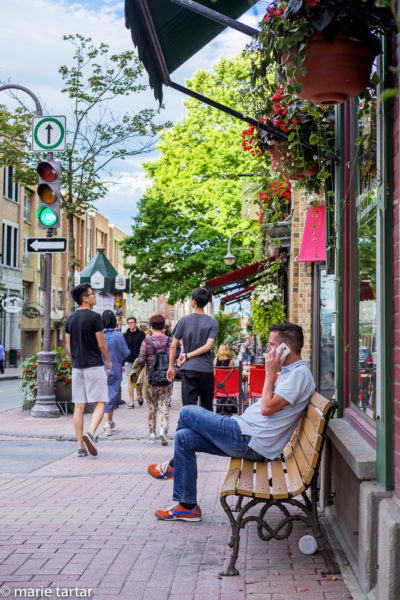
Rue St-Jean, the main shopping street of quartier St-Jean-Baptiste, home to North America’s oldest (and extremely well stocked) grocer, Épicerie J.A. Moisans
The same street (rue Saint-Jean, on the border between Montcalm and quartier Saint-Jean-Baptiste) yielded a chocolate treasure trove, at Érico Choco-Musée chocolaterie et pâtisserie. This would not be our only stop at 634, not for their petite Museum of Chocolate, but for their unctuous offerings, including a spicy chipotle and an usual truffle sesame, made with extra dark ganache, sesame seed oil, and tahini. It was indeed “un paradis pour chocophile!”
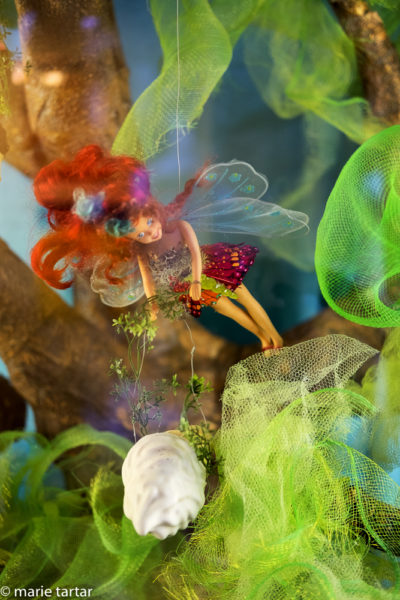
French Barbie in the window at Érico, un paradis pour chocophile, on rue St-Jean in Québec City, appears to be in a chocolate stupor
We had seen a mural tribute to Alfred Hitchcock earlier that day , which prompted us to watch Hitchcock’s “I Confess”, set in and shot in Québec City in gorgeous black and white in the early 50s.

In quartier St-Jean-Baptiste, Clarissa channels the master of suspense himself, Alfred Hitchcock, who filmed “I Confess” in Québec City
I confess, I thought I was pretty familiar with HItchcock’s filmography, but did not know this lesser gem. Movie star handsome Montgomery Clift plays Father Logan, who becomes a murder suspect, but is bound by his priestly vows from revealing to the police the identity of actual killer, who confessed to him. “I Confess” offers an interesting lens through which to gain an appreciation for the role of Catholicism in Québec history. Hitchcock chose to set and shoot “I Confess” in QC because it was the most Catholic city in North America.
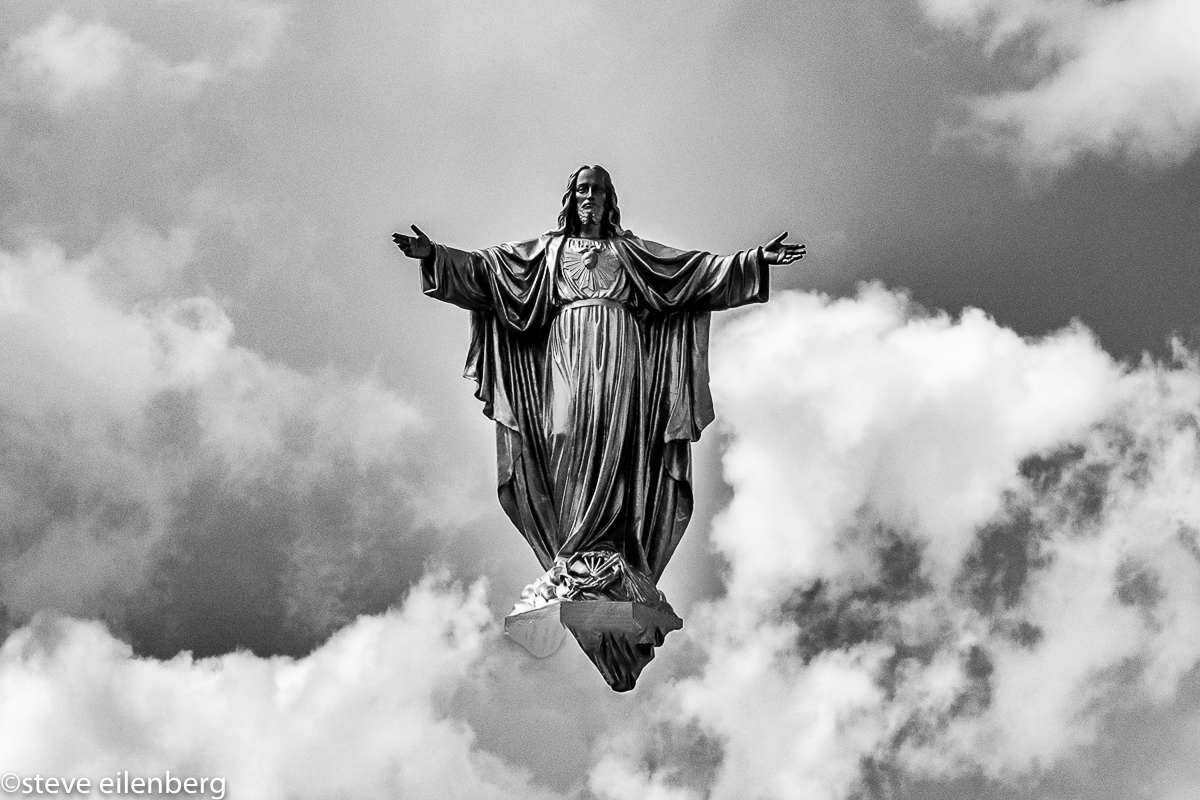
Historically, religion, specifically Catholicism, was very central to Québecois life. Christ levitates in QC, with a little Photoshop help from Steve, erasing his base.
Florence, our guide a few days later on a Québec City food tour of Saint-Roch, described how historically, to be French in Britain-controlled Québec was also to be Catholic. The Catholic church exerted its influence in every sphere of daily life, because to encourage propagation (many children) was to strengthen the French and thereby Catholic foothold in North America. Hitchcock was Catholic and this film, expounding on a favored theme of an innocent man unjustly accused of a crime, provides a fascinating meditation on guilt, innocence, purity and morality. Father Logan becomes a Christ-like figure, bearing the guilt for the crime, through the narrative and Hitchcock amplifies this theme visually in scenes juxtaposing the priest and Christian imagery. Frank Lloyd Wright granddaughter Ruth Baxter is a woman with a secret in her past (another favorite Hitchcock theme), which is exposed in her efforts to clear Father Logan.
Tuesday, July 19, 2016
Avocados procured two days earlier finally yielded themselves this morning to toast perfection. We made our first visit to the nearby Musée National des Beaux-Arts du Québec (MNBAQ), a wing of which we could actually see from the apartment. A spectacular new addition opened just weeks before our arrival, by Rem Koolhaas firm OMA (Shohei Shigematsu was the project lead) and Montreal firm Provencher_Roy. The virtually transparent Pierre Lasonde Pavilion reorients the museum’s entry to the Grande Allée, while connecting underground to the museum’s 3 other buildings.

Looking out the new Pierre Lasonde Pavilion, toward the reoriented entry to MNBAQ, now facing the Grand Allée.
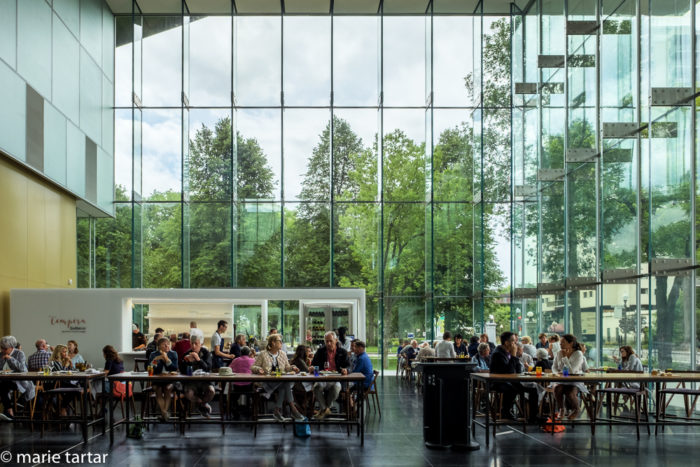
Restaurant in the new OMA-designed Pierre Lasonde Pavilion at MNBAQ, looking out to mature trees in the Fields of Abraham (also called Battlefields Park), scene of a historic battle of the French vs. the British in 1789
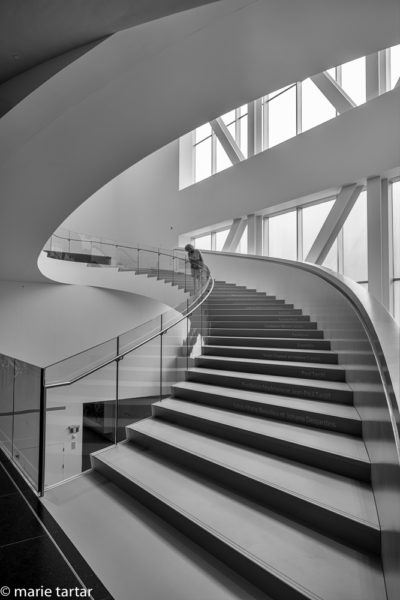
Sinuous curves of the staircase in the Pierre Lasonde Pavilion, a recently inaugurated OMA-designed addition to MNBAQ
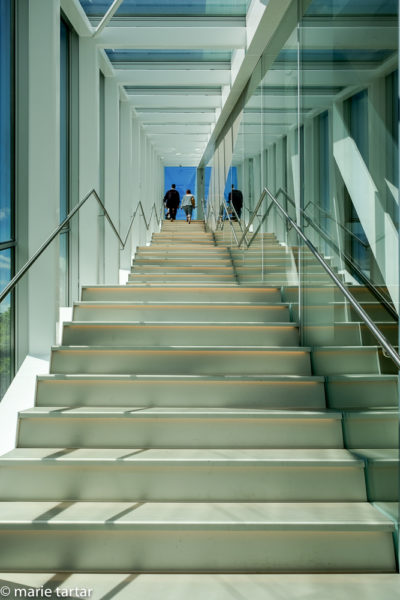
Stairway to heaven?: Exteriorized stairway at the OMA-designed Pierre Lasonde addition to MNBAQ in Québec City, recalling the signature escalator ascent at the Pompidou Center in Paris (WSJ comparison)
One can download a free app and use your own device for commentary on the collection. When I wasn’t wondering around goggling the building, I spent most my time in a show called Installations, on a Large Scale (Installations à Grande Echelle).

A favorite piece in the Installations à Grand Échelle exhibition at MNBAQ in Québec City, a mysterious portal by Claire Savoie
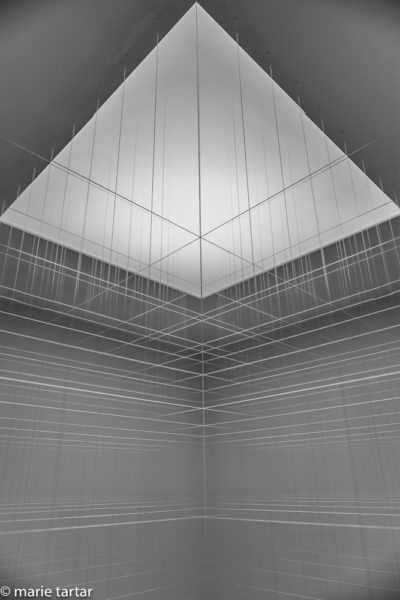
String theory: Quelque chose qu’on croit pouvoir tenir dans la main (What one believes can be held in one’s hand) by Claire Savoie at MDBAQ
We had a coffee break in an older red brick section which is a former jail, with a large tree turned sculpture (Durocher Street Tree) by Armand Vaillancourt.
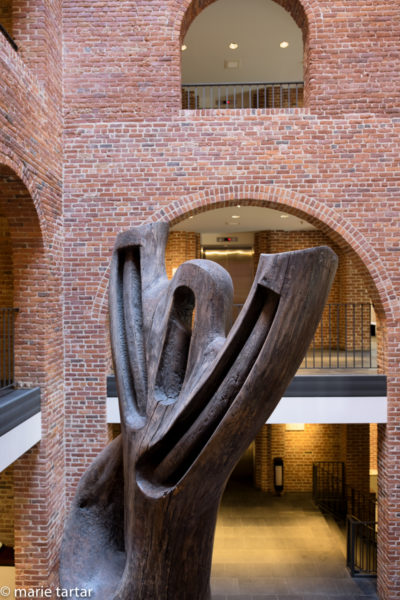
A pleasant place for a snack or coffee in an older section of MNBAQ, a brick former jail; I loved this tree turned sculpture by Armand Vaillancourt
I found a familiar name in the decorative arts and design section, our friend Gad Shaanan, for his industrial design firm’s innovative boot platform, aiming to minimize injury from stepping on a mine (also in the MOMA design collection).
In the afternoon, we headed downtown to pick up our rental car. We experienced first hand a sudden burst of intense rain and wind, sufficient to invert Clarissa’s umbrella, lending authenticity to a plot element in “I Confess,” in which the young Father Logan (in his pre-priest days) and his girlfriend Ruth Grandfort are caught out in a terrific storm, leading them into a potentially compromising situation.
Once the car was safely ensconced back in the garage, I headed out with a tripod in search of golden light and vistas from the Promenade des Gouverneurs. This boardwalk below La Citadelle, connecting the Plains of Abraham Battlefields Park with Terrasse Dufferin, has tremendous views across the St. Lawrence.

The elevation that made La Citadelle a natural choice as a fortress also lends itself to panoramic views of the mighty St. Lawrence River, with Lévis beyond forming the south bank of the river.

A little later and further east, from a perch on Terrace Dufferin: Cue the color, cue the full moon, rising over Lévis on the opposite bank of the St. Lawrence River.
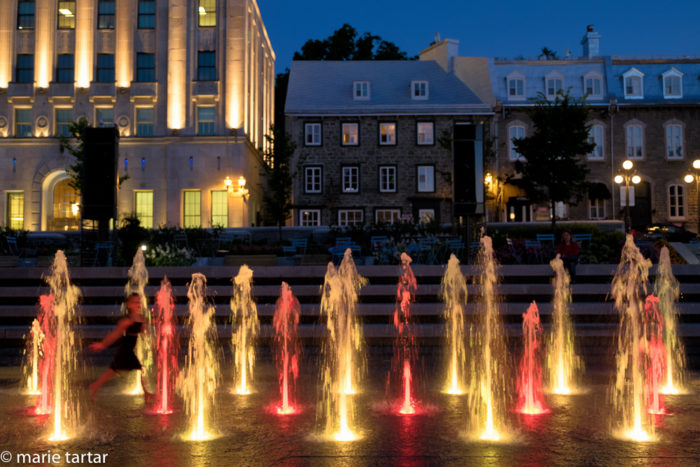
Just as I was heading home, this colorful fountain in front of Québec City’s Hotel de Ville and the ecstatic children playing in it waylaid me
Wednesday, July 20, 2016
Our mornings to this point in the trip had been rather leisurely. Normally, I am the one to crack (languidly) the whip, trying to rally the troops. Each arrival was allotted one morning after their arrival for a languid mobilization; Sunday morning was ours after our late Saturday arrival, Monday was Clarissa’s after arriving from NYC on Sunday. This morning, I was on the computer early and by 9 am, had signed us up for a food tour starting at 11 am. We were walking out of the house by 10 am to make our way north on foot to Saint-Roch, the “in” neighborhood per our hosts. Québec City Food Tours billed itself as “authentic” and “off the beaten path”, “a fun mix of culinary exploration and cultural immersion in Quebec City’s most diverse neighbourhood, St-Roch.” This sounded good, and our high expectations based on this were exceeded. The next 3 hours were spent hopscotching along rue St-Joseph Est, led by Florence. We had a stupendous start at well stocked Fromagerie des Grondines (199). We LOVED the “grilled cheese” sandwich (#12, Méditérranéen) so much, we returned several days later when Clarissa’s husband Jason had joined us so he could try it. A “grilled cheese” sandwich does not sound appealing to me, it sounds like kid’s food. This was actually a pressed sandwich of proscuitto, cheddar, and pesto on poppy bread, and was sandwich HEAVEN (and I am married to the panini king!). But that wasn’t all we tasted there! To go along with a taste of a raw milk cheese, Clos des Roches, we had a zesty tangerine colored juice, made from sea buckthorn berries. These berries are harvested by being shaken off a frozen branch. Like a souped-up orange juice, with 10 times the Vitamin C, and with a unique citrusy flavor all its own. We liked it so much we returned to the shop later in the day and made use of a discount coupon provided through the tour. We also sampled a small bowl of a terrific French onion soup made from veal stock, enlivened with a splash of balsalmic vinegar to finish it off. And this was just the first stop!
From there, we headed to Jardins St-Roch, an inviting green space of fountains and sculptures. Inaugurated in 1994 in its current form, it was formerly called “plywood city” , before being redeveloped in a program in which technology companies were offered tax advantages for 5 years if they located their offices in the neighborhood. Just off Blvd Charest Est is a short street lined with restaurants, one of which was our next destination, an artisanal brewery, the newest on the scene. Noctem Artisan Brasseurs (428 rue du Parvis) takes its name from Latin (Carpe noctem, seize the night; the nocturnal opposite of Carpe diem) and was started by 5 men, friends from college. We sampled an apricot beer, accompanied by a salt cured trout gravlax over black-eyed peas. Those who know me know I don’t often drink beer-too much bad beer in high school just about permanently put me off it, but in recent years and with the advent of the craft beer movement, I have been tasting more and occasionally finding beers I really like. I liked the apricot beer we tried here so much I actually ordered it when we returned for dinner with Jason a few nights later! Steve and Clarissa liked the triangular cat logo of Noctem so much they procured T-shirts. This T-shirt on Steve was met with knowing nods and approval a few days later by our 20-something year old guides at La Citadelle.

Under the trees at our last stop, La Barbarie Microbrewery, with our charming guide in a matching dress, Florence, fearless leader of our Québec City Food Tour of District Saint-Roch; this dark beer paired amazingly well with dark chocolate procured earlier from Champagne Chocolatier, an earlier stop
Along the way, Florence filled us in on the history of the neighborhood. Saint-Roch historically was a working class neighborhood, an industrial area, dominated by shipbuilding. Québec City was an important port, from which ships headed to England with cargos of wood . Returning ships were filled with brick ballast, which was turned into many downtown buildings. After a prolonged slump, the neighborhood has been successfully revitalized, beginning in about the year 2000, with a serious inflow of governmental funds, leading to its current status as the happening neighborhood. Florence pointed out interesting community projects, including a refrigerator inside a small wooden enclosure, outside of a church, in which one can leave doggie bags or extra food for the disenfranchised. One not so pleasant recurring experience in the neighborhood was being accosted occasionally by remarkably young appearing down and outs, presumably druggies. We definitely saw abundant examples of the café society described by Florence, of friendship and companionship being valued, with restaurant terraces overflowing towards week’s end with office workers celebrating birthdays and other occasions.
We loved our 3rd stop enough to return later in the day to stock up on teas, a lovely tea house called Camellia Sinensis at 624 rue St-Joseph Est. Our introduction to Québec’s signature fast food, poutine, was at Chez Ashton, a small local 24 hour chain. Reportedly, Chez Ashton plans to continue only in QC, because otherwise it would be too far from the Île d’Orleans source of one of the main ingredients, the potatoes. This is in keeping with their motto: “juste du frais, juste du vrai” (only fresh, only the real). There are conflicting accounts over the where and how poutine was invented, but it dates to the late 1950s or 1960s, and consists of squeaky fresh cheese curds and brown sauce (gravy) over fried potatoes. All accounts are that this combination is best appreciated at 3 am after a night of imbibing, and that apparently is when the lines for poutine are the longest. We did not test this theory, settling for enjoying the traditional version at Chez Ashton (tasty) and a gourmet version later in the week at Cassis Monna et Filles with duck confit (better). We never manage to try a favorite version of Florence’s, at nearby Le Projet. Chez Ashton apparently offers discounts in the winter to lure customers in (30% off if it is 30 degrees below 0!).
Along the way, we also saw evidence of the fallout of the Quiet Revolution, the name given to the movement by Québecois to secularize society by loosening the grip of the Catholic church on the educational system and affairs of state, from the 1960s on. Many churches have fallen into disuse as religious institutions. During our trip, we encountered churches repurposed as pop-up used bookstores, boutiques and community centers.
After a final beer tasting at La Barbarie Microbrewery at 310 rue St-Roch, a dark stout which paired amazingly well with dark chocolate procured earlier from Champagne Chocolatier (783 rue St-Joseph Est), we took leave of Florence and our fellow tasters and continued east to check out the gare du Palais Train Station and just beyond that, the Old Port Market, which sounds more enticing in French, Marché du Vieux-Port. The train station had a beautiful ceiling.
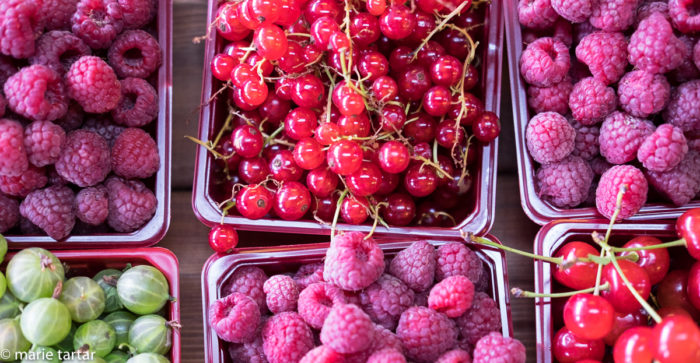
Bountiful baskets of berries in Marché de Vieux-Port of Québec City; many of the farm fresh products come from nearby Île d’Orléans, the “bread basket of Québec” and the “cradle of New France”; more details about Île d’Orléans and environs in a future post
The market was a great preview for our following day’s trip to Île d’Orléans. There were cheeses and ciders to taste and cassis products at Cassis Mona et Filles, convincing us that a proper visit to their Île d’Orléans premises was in order. After our extended lunchtime tasting tour and follow-up happy hour sampling at the Marché wore off, we enjoyed dinner at Grafitti on avenue Cartier before heading off to the airport to pick up Clarissa’s husband, Jason, incoming after a work day from NY.
Thursday, July 21, 2016
This was Jason’s morning for a leisurely start, but eventually we mobilized for a brief reconnoiter by car of La Citadelle, figuring out where to be for the changing of the guard the next day and then we were off to Île d’Orléans. We spent a lovely day circumnavigating this agro-tourism destination, the subject of a future post. To whet your appetite for it, here’s a lovely island church encountered there:
Back in Québec City, we had a late dinner at one of the microbreweries from our food tour, Noctet, sharing several savory dishes and of course, tall artisanal beers (even me!).

Happy beer drinking travel companions waiting for their food at Noctet in Québec City in happening quartier St-Roch
One dish, parmentier de casse-croute québécois réinventé, was described briefly as ‘boeuf effiloché servi sur pommes de terre grelots au gras de bacon, touillées avec choucroutes maison et purée d’ail confit, fromage en grain, jus de viande et émulsion de jalapenos fumés. Garni d’un oeuf en cuisson lente”. Parmentier usually means to me a version of shepherd’s pie, but the word actually just signifies made or served with potatoes. The name honors the Frenchman who popularized the potato in French cuisine in the second half of the 1700s. (Only a month later, I was to find myself at the potato-adorned grave of Frederick the Great, aka the Prussian “Potato King”, at Sans Souci in Potsdam, outside of Berlin. He is so called for his role in popularizing the potato in German cuisine. But that’s a story for another blog.) Basically, it was bacon fat enhanced potatoes with beef and sauerkraut, and was just delicious. The porc assiette was not bad either!
Friday, July 22, 2016
For the first time this entire trip, we actually set alarms, with the goal being to make it to La Citadelle in time for the changing of the guard at 10 am. Although I have never been interested in London in seeing the changing of the guard at Buckingham Palace, for some reason (probably photographic, namely better access), I was a little obsessed this trip with not missing this. I mean…full regimental dress, scarlet coats, brass buttons AND bearskin hats?! And, even a regimental goat?! I had to see this. So, what is it? In the summer, it is a daily event, a ceremonial changing of the guard, with soldiers of the Royal 22e Régiment who have been on 24 hour sentry duty being replaced by the new guard, which must undergo inspection by the officers to confirm their readiness for duty.
We set out shortly after 9 AM to walk there, not wanting to deal with parking near the old city. We were right on time, and with a good size crowd, were turned loose to swarm the parade grounds, which are surrounded by the buildings of La Citadelle, still an active military base. We were assured that we could see well from either side, but it was initially a little difficult to anticipate from which direction would emanate the guard.

The changing of the Guard at La Citadelle in Québec City, with regimental goat Batisse kept in check by a bear-skin hatted soldier of the Royal 22e Régiment
La Citadelle itself is a historic site, the largest British fort in North America. The star-shaped fort is an integral part of the historic fortifications of the city, and is situated strategically on the highest point of Cap Diamont. It was built over 30 years, finishing in 1850, as a response to a near invasion of Canada by the US in the War of 1812. The Royal 22e Régiment has been in residence at La Citadelle since 1920 and are the only French-speaking unit in the Canadian military. That’s right, this very English ceremony, based on the equivalent practice at Buckingham Palace, is conducted entirely in French. Batisse the goat, now Batisse XI, has been the official mascot since 1955. The first Batisse was a gift of the English Queen. La Citadelle is also an official residence of Canada’s Gouverneur Général. Historic events have taken place there. During WW II, strategies for the war were discussed at the Québec Conferences of 1943 and 1944, attended by Canada’s Gouverneur Général and Prime Minister, British PM Winston Churchill and US President Franklin D. Roosevelt. (In another wierd coincidence, less than a month later, again at Potsdam outside Berlin, I would find myself at Schloss Cecilienhof, site of the Potsdam Conference, where the post-WW II fate of Germany would be decided by Churchhill and his successor Attlee, Truman, and Stalin.)
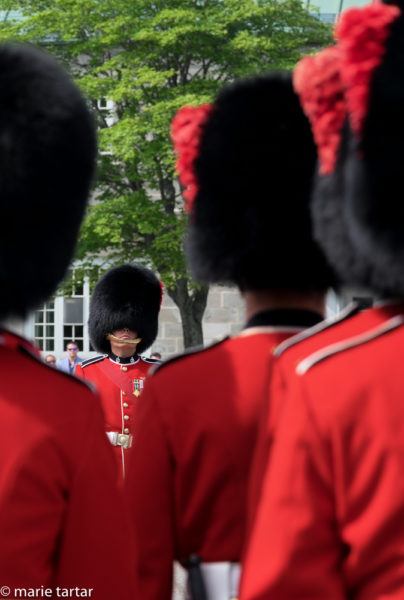
Officers inspect the incoming soldiers for readiness to assume the guard in a daily summer ceremony at La Citadelle in Québec City
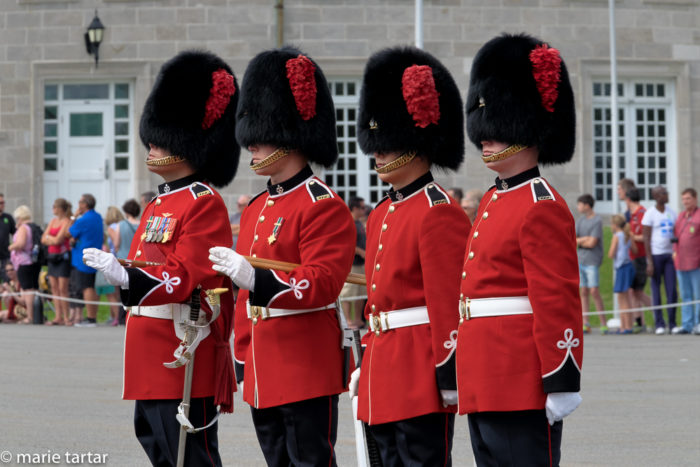
Scarlet-tunic’d, bearskin-hatted, gloved and ready to assume 24-hour sentry duties at Québec City’s La Citadelle, still an active military base
For pomp and circumstance, we were not disappointed. Accompanied by a military band, there was high-stepping, formations, shouting of commands, and mincing steps to even up lines. How the guard members can see with those bearskin helmets on, I do not know, but they performed admirably, even sidestepping an unchoreographeded mess one of the soldiers threw up, without missing a step.
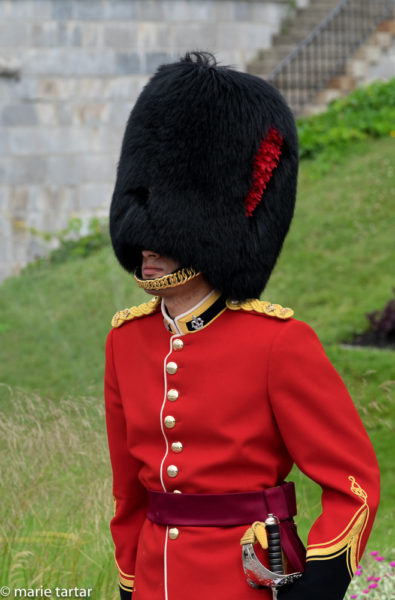
I really don’t see how the soldiers of the Royal 22cd Régiment can see to march and perform their maneuvers to music, but they manage, quite adroitly
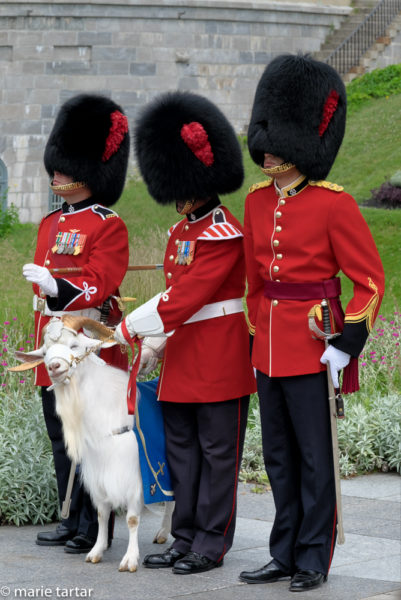
The most adorable member of the regiment, Batisse the goat, being kept in line by a Royal 22 Régiment soldier at La Citadelle
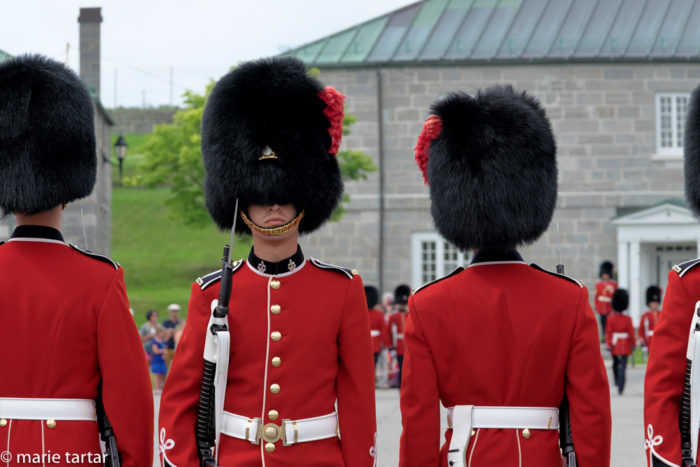
Members of the La Citadelle’s Royal 22e Régiment are affectionately known as the Van Doos (22 in French is vingt-deux, or phonetically, Van Doos)

Another great reason to visit La Citadelle while in QC, besides the history and pageantry, is great views of Vieux-Québec! On left, an early Art Deco style gratte-ciel (literally, scratch-sky or skyscraper), Édifice Price, inaugurated in 1931; on right, Chateau Frontenac. In 2009, as part of the 400th anniversary of the founding of QC, a tightrope walker traversed from one to the other!

Another view of Édifice Price and Vieux-Québec; the top 2 floors are the official residence of the Premier of Québec. Diminutive by today’s skyscraper standards, it was criticized initially as out of scale with the Historic District
Torrential rain held off long enough to complete our guided tour of La Citadelle after the changing of the guard ceremony (rain would have cancelled it, so that was lucky), and we had made it across the city walls into Vieux-Québec before it really opened up. We waited it out having lunch at La Bûche. Jason’s choice was the winner, a deconstructed shepherd’s pie, known here as pâte Chinois (Chinese pie; apparently Chinese immigrant’s favorite dish was shepherd’s pie), an unusually delicious version, but we all enjoyed our choices. Clarissa had the meat pie, me île d’Orléans sourced grilled vegetables drizzled with maple syrup and French onion soup, and Steve had an unusual version of split pea soup. The bathroom was an art project, covered with sanctioned graffiti, including this Québécois admonition: Be kind and eat poutine.
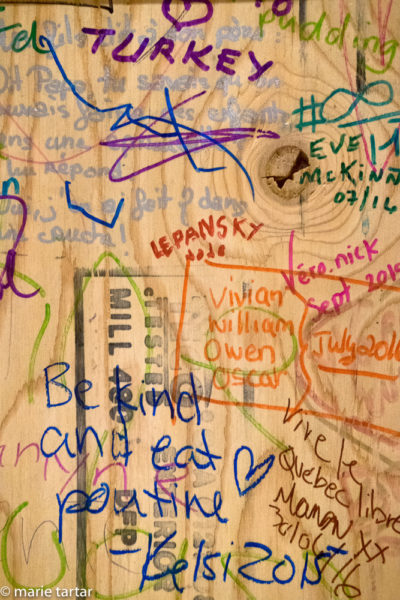
Canada’s Golden Rule? I think Kelsi is on to something here: “Be kind and eat poutine” covers a lot of situations.
The rain over, we stepped outside to find this adorable pup, peering out a car with a smiling owner at the wheel:

Friendly Québecois chien. Steve was a little freaked out by this photo, namely by the car owner’s happy expression and resemblance to his mother, Mary, who died in 2013 and would have turned 84 the following week
We devoted what remained of the afternoon to the Musée de la Civilisation in Basse-Ville, but it deserved more time. I managed to take in the Lifeline show of indigenous contemporary art from Australia. The museum is by famed Montréal Expo 67 architect, Moshe Safdie, and is a beautiful facility. We were to see other examples of Safdie’s work in Montréal the following week. San Diegans who know architecture will recognize the name for a local connection: his daughter, Taal Safdie, is one half of a well regarded husband and wife architecture firm, Safdie Rabines. We were to see other examples of Safdie’s work in Montréal the following week. San Diegans who know architecture will recognize the name for a local connection: his daughter, Taal Safdie, is one half of a well regarded husband and wife architecture firm, Safdie Rabines.
On the way home, we tarried a bit in the peaceful verdant restored historic cemetery at St. Matthew Anglican church on rue St-Jean.
Dinner at home featured haricots verts, procured the prior day from Île d’Orléans, embellished with our latest vegetal discovery, fleur d’ails (garlic flowers).
Saturday, July 23, 2016
We spent the day locally, starting with a visit to a charming cottage with a luxurious garden which we had passed near daily, at the corner of avenue Cartier and Grand Allée. This historic 1849 regency style cottage, Maison Henry-Stuart, was named both for the wife of the couple who built the house and the Stuart sisters who occupied it from 1918-1987. Having concentrated so much on the history of the French in this region, this gave us a look at English society in 19 century Québec, even being served tea and a delicious lemon cake from a Stuart sister recipe on the veranda overlooking the lush English garden.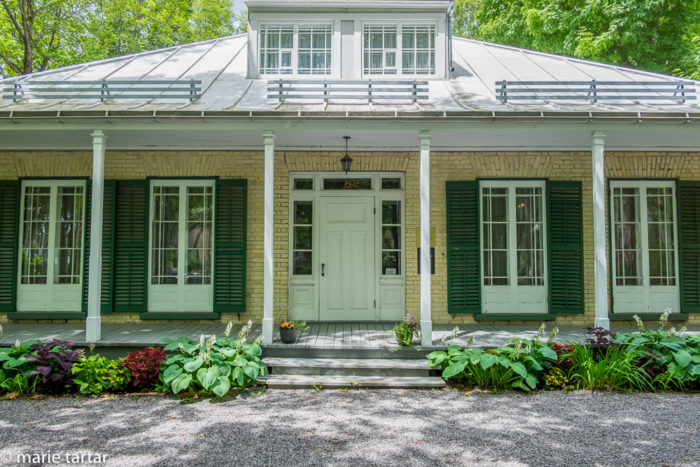
The afternoon was spent returning to the Musée Nationale des Beaux-Arts du Quebec (MNBAQ); this time, I managed to make it beyond the new building.
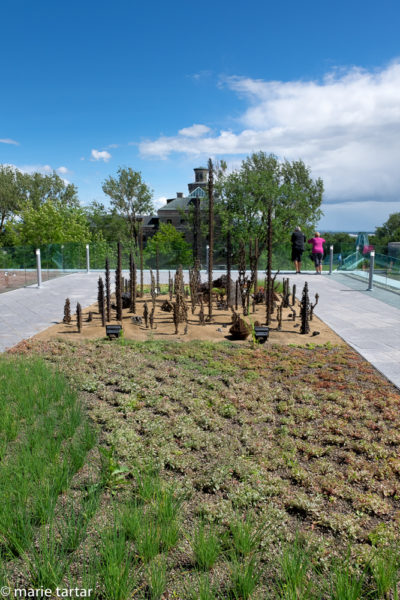
Great views of the Plains of Abraham (Battlefields Park) from the terraces of the new Pierre Lasonde Pavilion of MNBAQ in Québec City
I greatly admired the 3 long murals of Jean-Paul Riopelle which adorn the Riopelle passageway between the contemporary art and central pavilions. Entitled Tribute to Rosa Luxemburg (L’Hommage à Rosa Luxemburg), the 1992 work seems to be an oblique tribute to his former companion, American painter Joan Mitchell, who died in 1992. Rosa Luxemburg was a name I was to see later in the summer commemorated as street, plaza, and transit station names in Germany. “Red Rosa” was a Marxist theorist and anti-war activist who was murdered along with Karl Liebknecht in 1919.
Entitled Tribute to Rosa Luxemburg (L’Hommage à Rosa Luxemburg), the 1992 work seems to be an oblique tribute to his former companion, American painter Joan Mitchell, who died in 1992. Rosa Luxemburg was a name I was to see later in the summer commemorated as street, plaza, and transit station names in Germany. “Red Rosa” was a Marxist theorist and anti-war activist who was murdered along with Karl Liebknecht in 1919.
Four giants of Québecois art are highlighted in the collection with their own galleries, including Riopelle, as well as contemporaries Jean Paul Lemieux, Alfred Pellan, and Fernand Leduc. I also found the room-size plexiglass installation of David Altmejd “The Flux and the Puddle” fascinating and disturbing.
On the way to dinner in Nuovo St-Roch (another name for the revitalized quartier), we passed a Mondrianesque construction site:
One street over was the post-Modernist flipside:
We had an early dinner at Cafe du Cloucher Penché (203 St-Joseph Est), named for the leaning tower of the church across the street. After an oyster starter, I enjoyed very much my fish (merluche).
Having to vacate our table by 8 pm left plenty of light for additional stops. Jason, Clarissa, and I headed out to try to find a live music club, stopping first for a drink on the hidden patio of Le Sacrilège. We succeeded, sort of, ending up in the old town at Les Yeux Bleues. More entertaining to me than the actual headliner was the antics of a migrating bride to be, with her entourage, who stopped in for a set.
Sunday, July 24, 2016
We started our day taking Jason to Fromagerie des Grondines so he (and we) could have the famous “grilled cheese”. As it happens, it was instant replay, with Christophe starting a new group on the St-Roch food tour.

Christophe initiates a new group of Québec City Food Tour participants at Fromagerie des Grondines in quartier St-Roch
We were again headed out of town, first to the shrine of Sainte-Anne-de-Beaupré, a longtime pilgrimage site. We rounded out our day with interludes in the nature, including impressive Montmorency Falls. We had stopped at the bottom of the falls coming back from Île d’Orléans a few days before, but were discouraged by the gondola already being closed (it was 7:30 pm by then) and the cheesy evening lighting. Suffice to say, I’m glad we didn’t miss it. More details in a separate post on Québec City environs, but here’s a teaser image to show just how impressive these falls really are:
Our final dinner in QC (there are dining options at Parc de la Chute-Montmorency, but they were already closed by our early evening arrival) was at a creperie recommended by a friend of Clarissa and Jason’s . We were again near the ‘hood, at Crêperie-Bistro Le Billig (481 rue St-Jean). The duck confit crepes were indeed a treat, and I always enjoy artisanal cidre.
Monday, July 25, 2016
All too soon, it was time to pack it up and mobilize for our drive to Montréal. Clarissa and Jason stayed on another day, and managed to enjoy a few additional restaurants we had wanted to try, including Le Lapin Sauté on Petit-Champlain and Café Le Krieghoff on avenue Cartier, both recommendations of our hosts Denis and Suzanne. They also completed tracing our “I Confess” QC circuit by taking the ferry over to Lévis, scene of a chaste tryst between Father Logan and Ruth Grandfort in the movie. As for Steve and me, we ditched the car as soon as we arrived in Montréal, and were soon happily tasting, walking and photographing our way through many wonderful new culinary, artistic and historic personal discoveries-stay tuned!
-Marie
Save

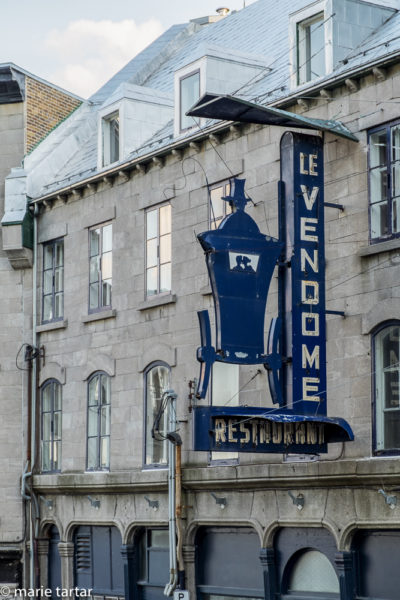
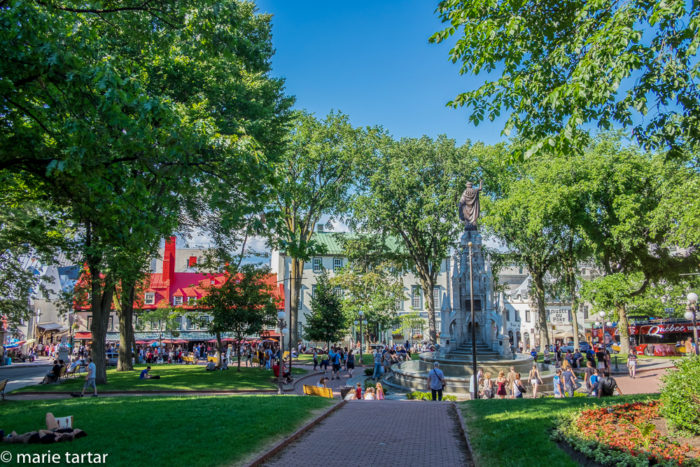
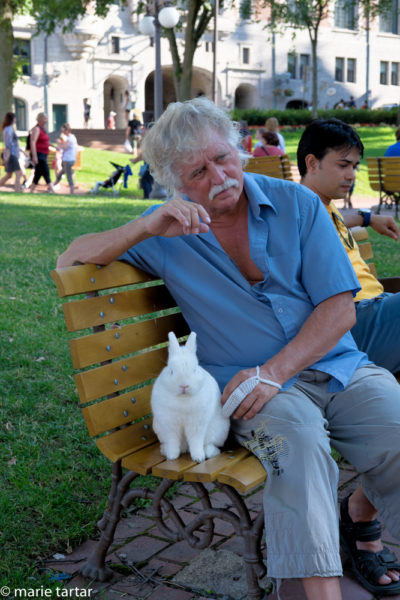


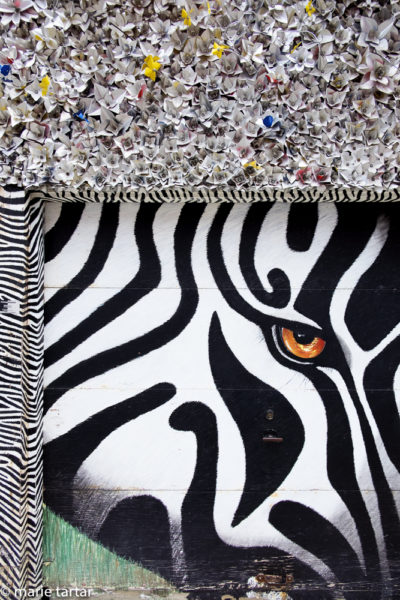
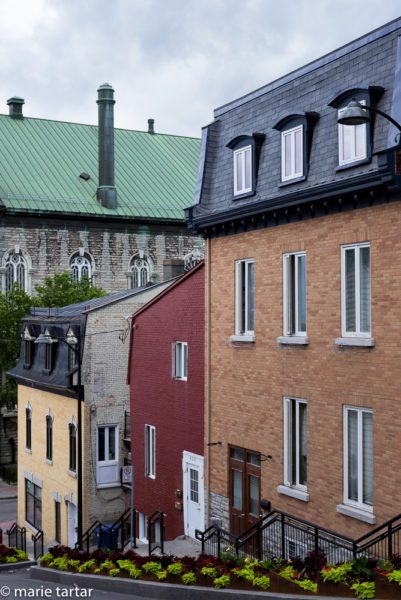
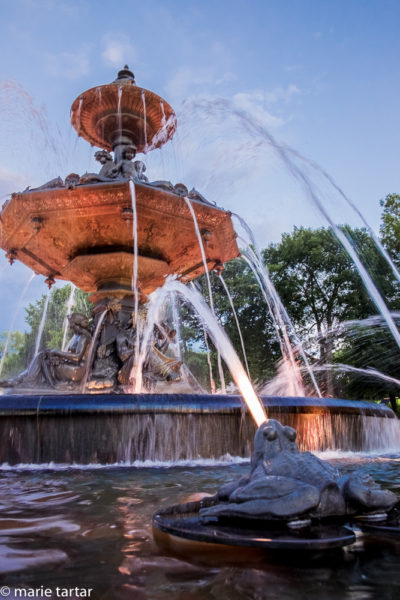

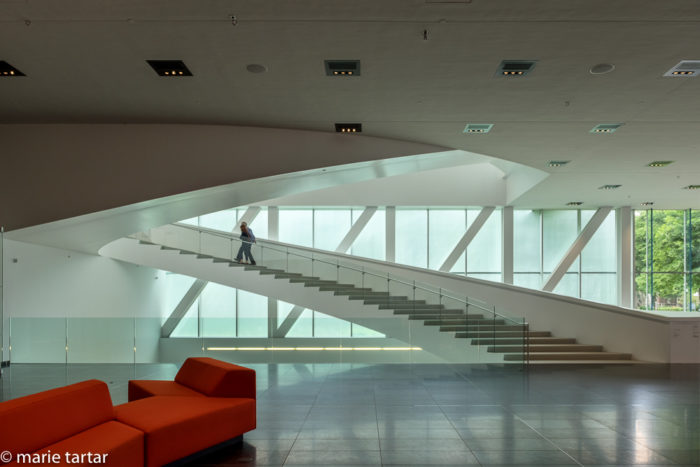
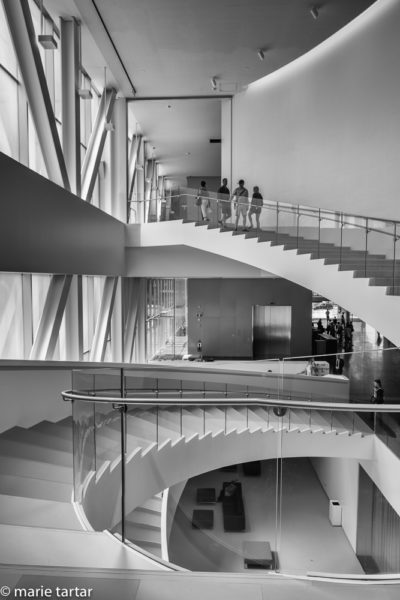
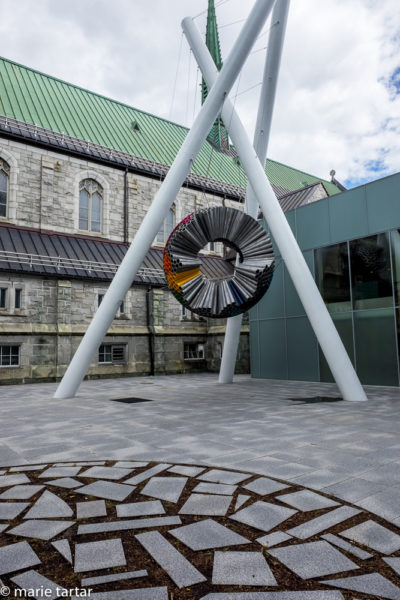

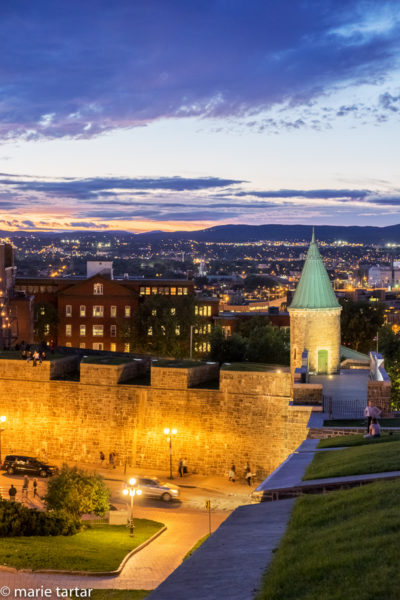
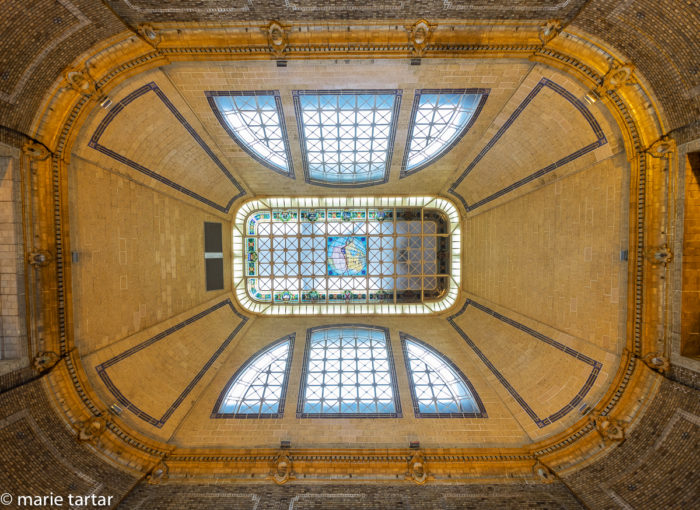



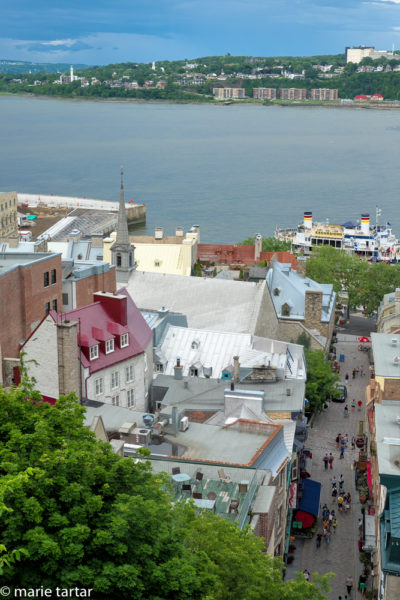
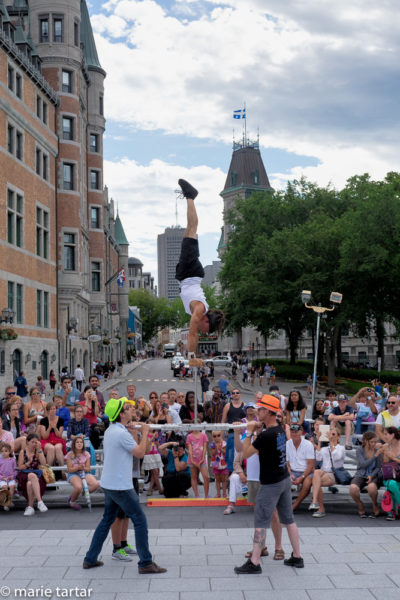
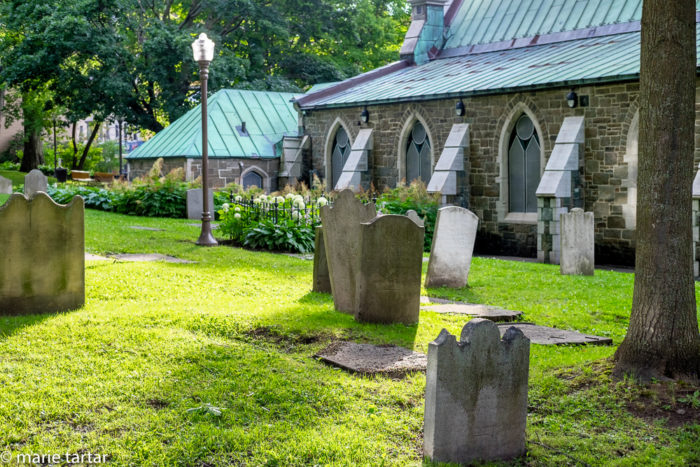
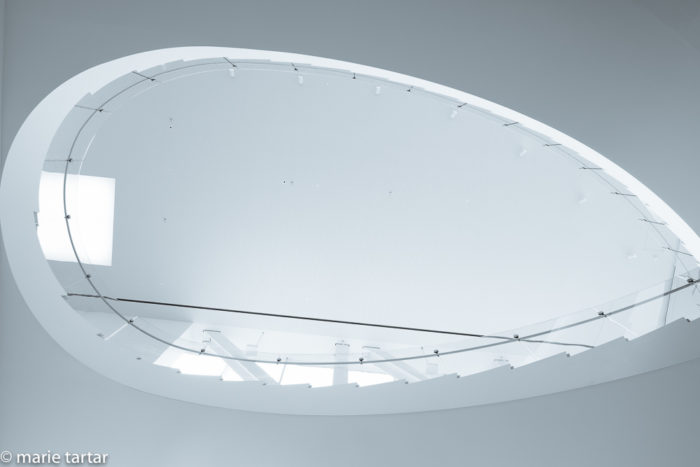
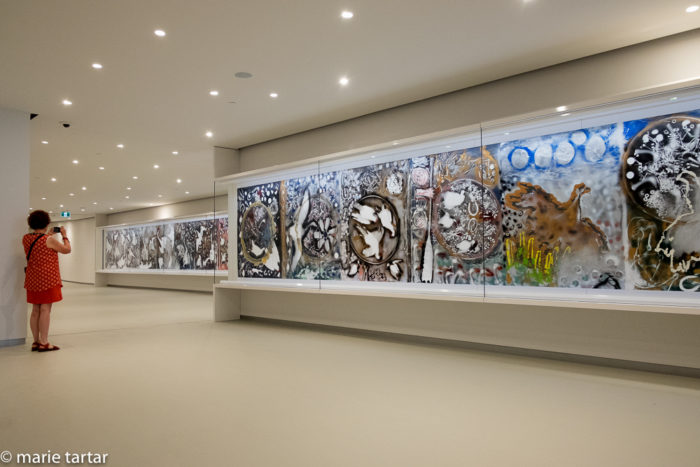
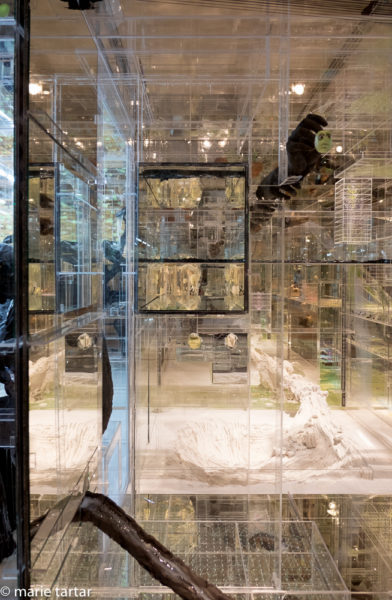
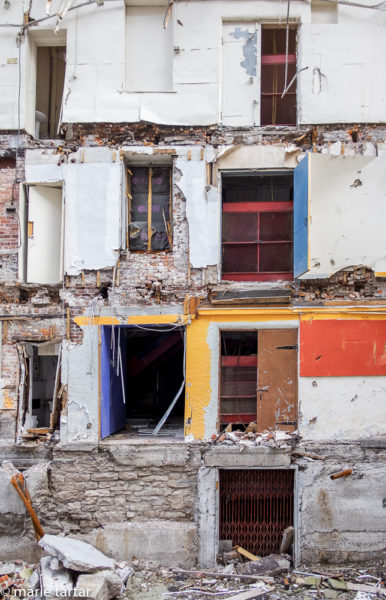
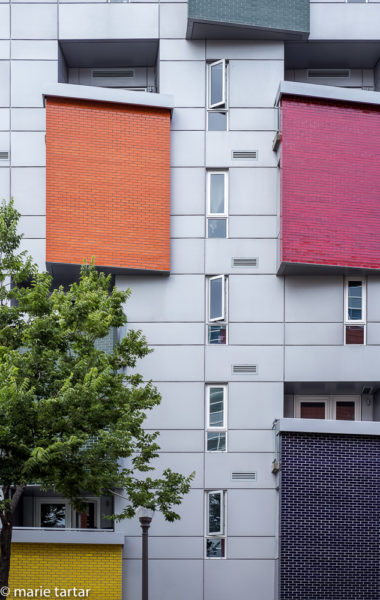
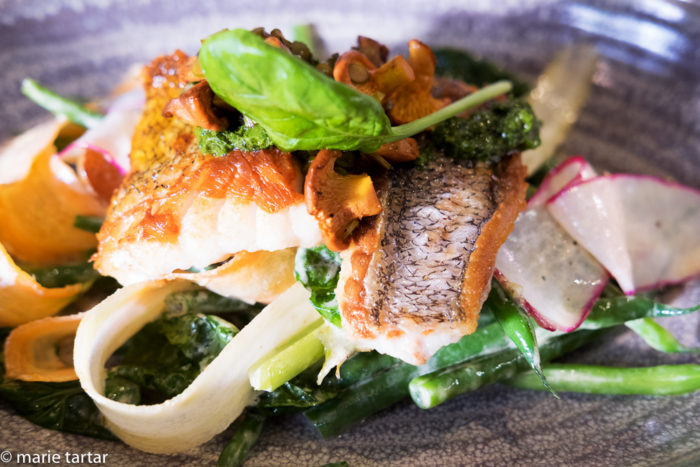
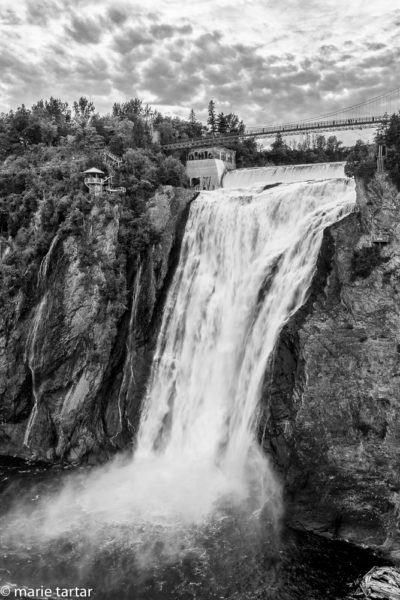
Lovely travelogue – nice way to spend some quiet time on Memorial Day. Staying tuned for Montreal-
Thanks, Heather, I think you would have particularly enjoyed the new art museum addition!
-M
I really love the photo of the benches and their shadows–so cool.
Thanks, Susan, that is my favorite as well!
-M